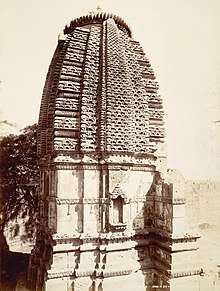Ranakadevi
Ranakadevi was a legendary 12th century queen of Khengara, the Chudasama ruler of Saurashtra region of western India. She is mentioned in the bardic tragic romance representing the battle between Chudasama king Khengara and Chaulukya king Jayasimha Siddharaja.[1] However, this legend is not credible.[2]
Legend of Ranakadevi
Ranakadevi was a daughter of potter of Majevadi village near Junagadh, the Chudasama capital. The fame of her beauty reached to Jayasimha and determined to marry her. Meanwhile Khengara marry her which enraged Jayasimha.[1][3] A variation of legend tells that she was born to the king of Kutch but she was abandoned in forest as the astrologer had predicted that whomever marry her will lose his kingdom and die young. The abandoned child was found a potter named Hadmat or Jam Rawal who raised her as his own daughter.[4][5] Meanwhile Khengara had attacked and broken gates of Jayasimha's capital Anahilapataka (now Patan) when he was on an expedition to Malwa which had further enraged Jayasimha.[6][5]
Khengara used to stay himself at the fort of Uparkot in Junagadh but kept his queen Ranakadevi in his palace in the hill fort of Girnar, a mountain near Junagadh. His nephews Visal and Desal were the only persons allowed access there except the guard. Khengara used to go from the Uparkot to the Girnar fort to visit Ranakadevi. One day he found Desal drunk there and, in spite of all his protestations, accused him of an improper intimacy with her. Then he expelled both Desal and Visal from the Junagadh.[6][5]
They went to Jayasimha and told him to attack Junagadh. They entered the Uparkot with some cattle carrying grain, slew the guards and attacked the palace. Khengara came forth and fought and died in the battle and the Uparkot was taken. After this Desal and Visal took Jayasimha up to the Girnar fort and asked their aunt to open the gate. She did so not knowing what had happened. Then Jayasimha entered and on seeing her two sons ordered them to be put to death. Jayasimha took Ranakadevi with him and returned towards Anahilapataka.[6][5]
On their way, at Vardhamanapura (now Wadhwan) on the banks of river Bhogavo, overcome by the noble bearing of Ranakadevi, he offered to make her his first queen but she told him that nothing would make her forgive him the death of her innocent boys and his husband. She then cursed Jayasimha and warned him that he should die childless. The she mounted committed sati by burning herself on the funeral pyre of her husband with his husband's turban in her lap. Her curse was fulfilled and Jayasimha died childless.[6][5][7]
Historicity

Several Sorathas (couplets) uttered by Ranakadevi in the bardic accounts evokes sadness but their usefulness as the historical material is doubtful. Even the existence of Ranakadevi is doubtful. Ranakadevi is not mentioned in the Chaulukya era chronicles such as Puratana-prabandha-sangraha or Merutunga's Prabandha-Chintamani but instead they give name Sonaladevi and Sunaladevi respectively. The Apabhramsa verses uttered by Sonaladevi after the death of Khengara counts eleven and eight in them respectively.[1][3]
Ranakadevi's paliya (memorial stone) and a shrine still stands on the southern banks of Bhogavo river in Wadhwan, though the temple seem to be built earlier probably during the reign of Dharanivaraha of Chhapa dynasty (last quarter of the 9th century).[8] It is the protected national monument.[9]
In popular culture
Several variation of this legend are still popular in bards and peoples of Saurashtra. Some of the verses of the ballad of Khengara and Ranakadevi are very poetical.[10] Many verses are given in the Ras Mala by Alexander Kinloch Forbes.[3] One such verse is:
For shame murderous Girnar, Why were you not bent crooked; When died Ra Khengara, Thus wept Ranakadevi.[3]
Ranakdevi (1883), a Gujarati novel written by Anantprasad Trikamlal Vaishnav, is based on her.[11] The Amar Chitra Katha has published a comics, Ranak Devi: The Story of a Great Queen of Saurashtra (1977, #452) based on the legend.[4]
She is a character in Sadhara Jesang, a Vesha (play) of Bhavai, the folk theatre of Gujarat.[12] Gadh Juno Girnar (1967) is a Gujarati play based on the legend.[13] Two silent films about Ranakadevi are produced; one in 1923 directed by S. N. Patankar and another in 1930 produced by Chandulal Shah and directed by Nanubhai Vakil. The Gujarati film Ranakdevi (1946) starring Nirupa Roy and directed by Vishnukumar M. Vyas was also produced.
References
- Parikh, Rasiklal C. (1938). "Introduction". Kavyanushasana by Acharya Hemachandra. II Part I. Bombay: Shri Mahavira Jaina Vidyalaya. pp. CLXXVIII–CLXXXIII.
- Majumdar 1956, p. 69.
- Campbell, James Macnabb (1896). Gazetteer Of The Bombay Presidency: History of Gujarat. I. Part I. Bombay: The Government Central Press. pp. 175–177.
- Pai (1 April 1971). Ranak Devi. Amar Chitra Katha Pvt Ltd. ISBN 978-93-5085-089-3.
- Alaka Shankar (2007). "Ranak Devi". Folk Tales Of Gujarat. Children's Book Trust. pp. 43–49. ISBN 978-81-89750-30-5.
- Watson, James W., ed. (1884). Gazetteer of the Bombay Presidency : Kathiawar. VIII. Bombay: Government Central Press. pp. 493–494.

- Poonam Dalal Dahiya (15 September 2017). ANCIENT AND MEDIEVAL INDIA EBOOK. MGH. p. 540. ISBN 978-93-5260-673-3.
- Dhaky, Madhusudan A. (1961). Deva, Krishna (ed.). "The Chronology of the Solanki Temples of Gujarat". Journal of the Madhya Pradesh Itihas Parishad. Bhopal: Madhya Pradesh Itihas Parishad. 3: 10–12.
- Manohar Sajnani (2001). Encyclopaedia of Tourism Resources in India. Gyan Publishing House. p. 118. ISBN 978-81-7835-018-9.
- Devendra Satyarthi (1987). Meet My People: Indian Folk Poetry. Navyug. p. 228.
- "Chapter 2". A comparative study of the major historical novels of Sir Walter Scott and Shri Kanaiyalal Munshi (Thesis). p. 59.
- Bharati Ray (2009). Different Types of History. Pearson Education India. pp. 380–381. ISBN 978-81-317-1818-6.
- Enlite. 2. Light Publications. 1967. p. 55.
Bibliography
- Majumdar, Asoke Kumar (1956). Chaulukyas of Gujarat. Bharatiya Vidya Bhavan.CS1 maint: ref=harv (link)